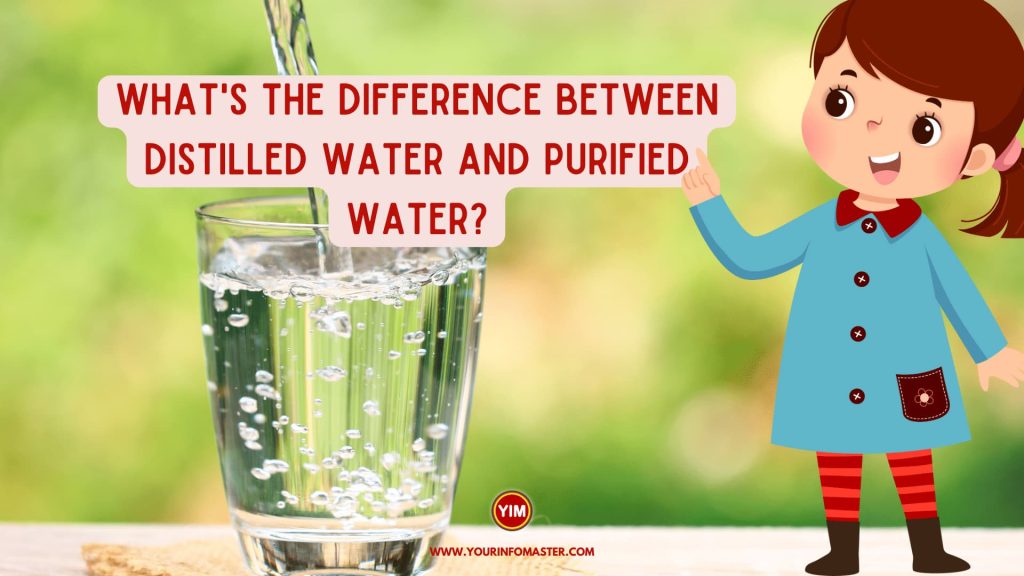I am going to explain the blog post “What’s the difference between distilled water and purified water?“
Distilled water and purified water are two terms that are often used interchangeably, but they are not the same. Both types of water are treated to remove impurities, but the methods used are different. In this blog post, we will explore the differences between distilled water and purified water. We will cover ten key differences between these two types of water to help you understand the distinction between them.
Distilled water and purified water are essential for many applications, including medical procedures, laboratory testing, and industrial processes. Understanding the differences between these two types of water can help you make informed decisions when choosing the right water for your specific needs.
Check also: Which is the best browser for ChatGPT: A comprehensive guide
10 Differences between distilled water and purified water
Here is a list of 10 differences between distilled water and purified water:
- Method of purification
- Chemical composition
- Mineral content
- Taste
- pH level
- Cost
- Shelf life
- Environmental impact
- Health benefits
- Applications
Check also: 10 Best Chrome Extensions for ChatGPT
Detail of 10 Differences between distilled water and purified water
Here is the detail of 10 differences between distilled water and purified water:
Method of purification
Distilled water is created by boiling water and collecting the steam as it condenses. The steam is then cooled and collected as distilled water. This process removes most impurities, including minerals, bacteria, and viruses. Purified water, on the other hand, can be created using several methods, including reverse osmosis, deionization, and carbon filtration. Each method removes impurities differently, but all result in water that is considered purified.
Chemical composition
Distilled water is free of all minerals and chemicals, making it chemically pure. Purified water, on the other hand, may contain some minerals and chemicals, depending on the purification method used.
Read also: How to Hire a Personal Injury Lawyer?
Mineral content
Distilled water has no mineral content, while purified water may contain trace amounts of minerals.
Taste
Distilled water has a flat, neutral taste due to the lack of minerals. Purified water can have varying tastes, depending on the minerals and chemicals that remain after purification.
pH level
Distilled water has a pH level of 7, which is neutral. Purified water can have varying pH levels, depending on the source water and the purification method used.
Cost
Distilled water is generally more expensive than purified water because of the energy required to boil and condense the water. Purified water is often cheaper because the purification methods are less energy-intensive.
Shelf life
Distilled water has a longer shelf life than purified water because it is free of any minerals or contaminants that could cause it to spoil. Purified water may have a shorter shelf life due to the possibility of contaminants re-entering the water during storage.
Environmental impact
Distilled water has a higher environmental impact than purified water because of the energy required to create it. The process of boiling and condensing water requires a significant amount of energy, which contributes to greenhouse gas emissions. Purified water, on the other hand, has a lower environmental impact because the purification methods used are less energy-intensive.
Health benefits
Distilled water has no health benefits over purified water. In fact, the lack of minerals in distilled water can be harmful to the body if consumed in large quantities over a long period. Purified water, on the other hand, can provide health benefits if it contains minerals that are beneficial to the body.
Applications
Distilled water is commonly used in medical procedures, laboratory testing, and industrial processes that require pure water. Purified water is used in a variety of applications, including drinking water, cooking, and brewing.
Check also: Exploring the Relationship Between Bing and ChatGPT: Does Bing Use ChatGPT?
Conclusion
In conclusion, distilled water and purified water are two types of water that are often confused with each other. While both are treated to remove impurities, the methods used are different, resulting in water with different chemical compositions, tastes, and properties.
Distilled water is created by boiling and condensing water, resulting in water that is chemically pure and free of all minerals and contaminants. It has a neutral taste, a pH level of 7, and is commonly used in medical and industrial applications that require pure water.
Purified water, on the other hand, can be created using various methods, including reverse osmosis, deionization, and carbon filtration. It may contain trace amounts of minerals and chemicals, depending on the purification method used, and can have varying tastes and pH levels.
While both types of water have their advantages and disadvantages, it’s essential to understand the differences between them and choose the right type of water for your specific needs. Whether you need pure water for laboratory testing, medical procedures, or simply drinking water, understanding the differences between distilled water and purified water can help you make an informed decision.
See also: ChatGPT is at Capacity Right Now: Temporary Inability to Accept New Requests
If you really enjoyed the article “What’s the difference between distilled water and purified water?,” then I would be very grateful if you’d help it spread by emailing it to your friends or sharing it on Twitter, Instagram, or Facebook. Thank you!
Have you read “What’s the Difference between distilled water and purified water?“ Which of these blogs are you reading, and how is it similar to one of them?

